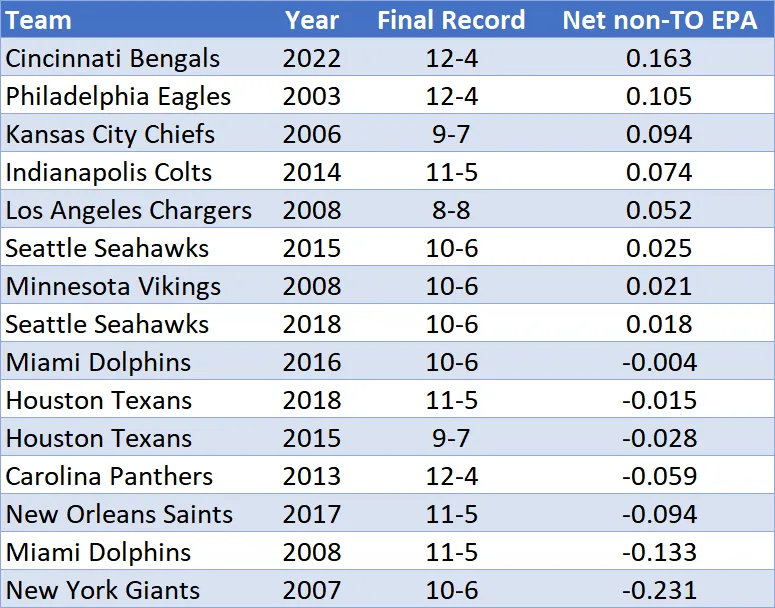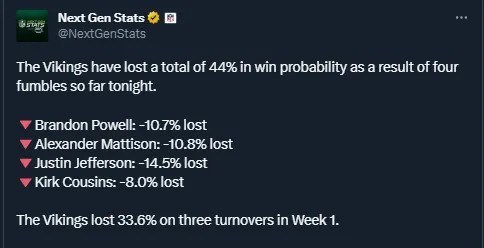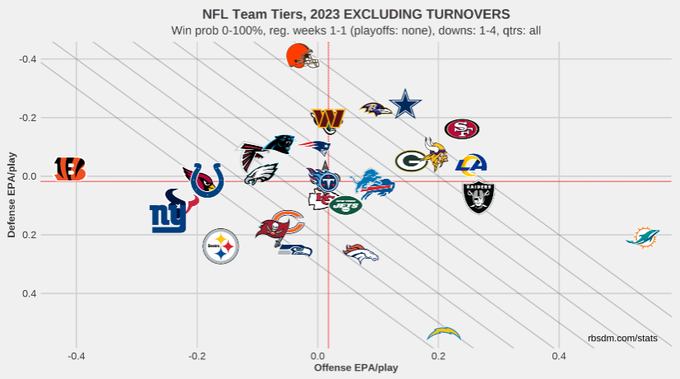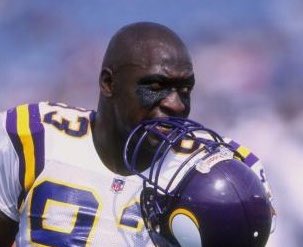Post by Funkytown on Sept 15, 2023 8:21:54 GMT -6
Remember the fun thread from last season? Well, let's talk about it.
Last year we probably weren't as good as our record, but this year, are we as bad as our record?!


Arif Hasan: It’s Too Early to Call Them the Reverse 2022 Minnesota Vikings But, Man.
Always great stuff from Arif. Subscribe to his Substack if you haven't.
Last year we probably weren't as good as our record, but this year, are we as bad as our record?!

Can't wait to see this updated.

Arif Hasan: It’s Too Early to Call Them the Reverse 2022 Minnesota Vikings But, Man.
The Vikings were a team with a -3 point differential to close out the season last year and played like it in the playoffs. These things happen and the front office seemed aware that they couldn’t coast on last year’s results. They turned over some key players on both sides of the ball and attempted to restock.
So far, it isn’t working.
Sort of.
This Vikings team seems to be exactly as fraudulent as last year’s Vikings team. But last year’s team tricked people with fluky wins. This one is doing the same with losses. And it’s not hard to see why it matters.
Let’s talk about “0-2”
A Closer Look At 0-2
Only one out of every ten teams to go winless to start the season makes the playoffs. Those odds aren’t catastrophic and probably aren’t worth giving up on a team for, but there’s another reason to ignore them.
The dirty secret about the 0-2 statistic – one that holds up when accounting for the size of the league and the size of the playoffs – is that it’s mostly a result of the fact that teams that start the season with two losses are generally bad at football.
Conflating the 2013 Carolina Panthers or the 2015 Seahawks with the 2008 Lions or 2017 Browns is kind of silly. A team with good fundamentals and a fluky record is much more likely to turn their season around than a team without those elements.
I don’t think any team is a better example of that than last year’s Cincinnati Bengals. They went 0-2 and not many people cared all that much. It turns out that refusing to ring the alarm bells was the right call; they won 12 of their next 14 games – cancelling one – to finish the season with a 12-4 record.
The 2003 Eagles started off the season with the same record and finished a few plays away from a Super Bowl appearance
We knew those teams were good because of their history – the Eagles went 12-4 the previous season and made the conference championship game while the Bengals were coming off of a Super Bowl loss the year prior.
But we also knew they were good because they played well in those losses – games that turned around, in part, because of turnovers. The Bengals were 5-1 in the turnover battle in their two losses, while the Eagles went 8-1.

0-2 Playoff Teams
They also largely outplayed their opponents aside from that, with the Bengals racking up +0.163 net expected points per play on non-turnover plays and the Eagles earning +0.105 net expected points per play on non-turnover plays.
None of this is to say the 2003 Eagles or 2022 Bengals deserved to win the games that they lost. They didn’t. Rather, it’s to say that there was reason to believe the season could be turned around. Turnovers are fluky and don’t represent the balance of play both teams were able to bring to the table.
Those teams ranked first and seventh in net non-turnover EPA among all 0-2 teams over the last 20 years, a group of 169 teams.
You can see where this is going. The Vikings net non-turnover EPA over two weeks was +0.147, which would rank third among that group. That doesn’t mean their odds are good, but it does mean their odds are much better than the typical 0-2 team.
On average, winless teams through two weeks since 2003 generate -0.104 net non-turnover EPA per play. They finish with an average winning record of .352, or about 6-11 in a 17-game season. In that 20-year sample, the playoff make rate is 8.9 percent and rises to 9.5 percent when adding a seventh seed to both conferences.
But of teams with a net positive EPA per play on non-turnover plays – a group of just 33 teams in the 169-team sample – the playoff make rate is 24.2 percent, becoming 33.3 percent in a 14-playoff bracket.
And of teams with a score of +0.100 or higher per play the make rate is 33.3 percent in their respective years and 55.5 percent in the 14-team playoff era. On average, they finish with a .497 record, which would mean 8-8-1.
Those aren’t amazing odds but they definitely aren’t bad. In a way, the Vikings are actually better off than a team picked at random before the season begins. After all, only 43.8 percent of teams get to make the playoffs this year.

Oof.
This isn’t to say the Vikings should ignore what happened. They need to do all the things coaches will say after performances like this – work on ball security, refocus on the fundamentals, regroup and so on – that’s important.
Regression occurs not just because everything that is unstable is also random. It’s in part because teams and players correct on easily correctable but impactful things, like turnovers.
If one team never drilled fumble recovery, they would indeed have a poor fumble recovery rate to end the season. But one can only become so good at recovering fumbles. Every team tends to hit that level of skill, making the fumble recovery rate in the NFL about 50 percent. So the Vikings will need to make sure they are at that level.
In the same way those Eagles and Bengals teams did not deserve to win those lost games, the Vikings did not deserve to win against Philadelphia this week. They turned the ball over four times to once again net three lost turnovers. The Vikings went 7-1 in turnover differential over two weeks. They can’t do that.
That’s something they have to wrestle with and correct. But in terms of setting expectations for fans going forward, there’s no reason to panic.
So far, it isn’t working.
Sort of.
This Vikings team seems to be exactly as fraudulent as last year’s Vikings team. But last year’s team tricked people with fluky wins. This one is doing the same with losses. And it’s not hard to see why it matters.
Let’s talk about “0-2”
A Closer Look At 0-2
Only one out of every ten teams to go winless to start the season makes the playoffs. Those odds aren’t catastrophic and probably aren’t worth giving up on a team for, but there’s another reason to ignore them.
The dirty secret about the 0-2 statistic – one that holds up when accounting for the size of the league and the size of the playoffs – is that it’s mostly a result of the fact that teams that start the season with two losses are generally bad at football.
Conflating the 2013 Carolina Panthers or the 2015 Seahawks with the 2008 Lions or 2017 Browns is kind of silly. A team with good fundamentals and a fluky record is much more likely to turn their season around than a team without those elements.
I don’t think any team is a better example of that than last year’s Cincinnati Bengals. They went 0-2 and not many people cared all that much. It turns out that refusing to ring the alarm bells was the right call; they won 12 of their next 14 games – cancelling one – to finish the season with a 12-4 record.
The 2003 Eagles started off the season with the same record and finished a few plays away from a Super Bowl appearance
We knew those teams were good because of their history – the Eagles went 12-4 the previous season and made the conference championship game while the Bengals were coming off of a Super Bowl loss the year prior.
But we also knew they were good because they played well in those losses – games that turned around, in part, because of turnovers. The Bengals were 5-1 in the turnover battle in their two losses, while the Eagles went 8-1.

0-2 Playoff Teams
They also largely outplayed their opponents aside from that, with the Bengals racking up +0.163 net expected points per play on non-turnover plays and the Eagles earning +0.105 net expected points per play on non-turnover plays.
None of this is to say the 2003 Eagles or 2022 Bengals deserved to win the games that they lost. They didn’t. Rather, it’s to say that there was reason to believe the season could be turned around. Turnovers are fluky and don’t represent the balance of play both teams were able to bring to the table.
Those teams ranked first and seventh in net non-turnover EPA among all 0-2 teams over the last 20 years, a group of 169 teams.
You can see where this is going. The Vikings net non-turnover EPA over two weeks was +0.147, which would rank third among that group. That doesn’t mean their odds are good, but it does mean their odds are much better than the typical 0-2 team.
On average, winless teams through two weeks since 2003 generate -0.104 net non-turnover EPA per play. They finish with an average winning record of .352, or about 6-11 in a 17-game season. In that 20-year sample, the playoff make rate is 8.9 percent and rises to 9.5 percent when adding a seventh seed to both conferences.
But of teams with a net positive EPA per play on non-turnover plays – a group of just 33 teams in the 169-team sample – the playoff make rate is 24.2 percent, becoming 33.3 percent in a 14-playoff bracket.
And of teams with a score of +0.100 or higher per play the make rate is 33.3 percent in their respective years and 55.5 percent in the 14-team playoff era. On average, they finish with a .497 record, which would mean 8-8-1.
Those aren’t amazing odds but they definitely aren’t bad. In a way, the Vikings are actually better off than a team picked at random before the season begins. After all, only 43.8 percent of teams get to make the playoffs this year.

Oof.
This isn’t to say the Vikings should ignore what happened. They need to do all the things coaches will say after performances like this – work on ball security, refocus on the fundamentals, regroup and so on – that’s important.
Regression occurs not just because everything that is unstable is also random. It’s in part because teams and players correct on easily correctable but impactful things, like turnovers.
If one team never drilled fumble recovery, they would indeed have a poor fumble recovery rate to end the season. But one can only become so good at recovering fumbles. Every team tends to hit that level of skill, making the fumble recovery rate in the NFL about 50 percent. So the Vikings will need to make sure they are at that level.
In the same way those Eagles and Bengals teams did not deserve to win those lost games, the Vikings did not deserve to win against Philadelphia this week. They turned the ball over four times to once again net three lost turnovers. The Vikings went 7-1 in turnover differential over two weeks. They can’t do that.
That’s something they have to wrestle with and correct. But in terms of setting expectations for fans going forward, there’s no reason to panic.
Always great stuff from Arif. Subscribe to his Substack if you haven't.













 Okay! Back in the game!
Okay! Back in the game!









 ... and neither is this Chris guy.
... and neither is this Chris guy.